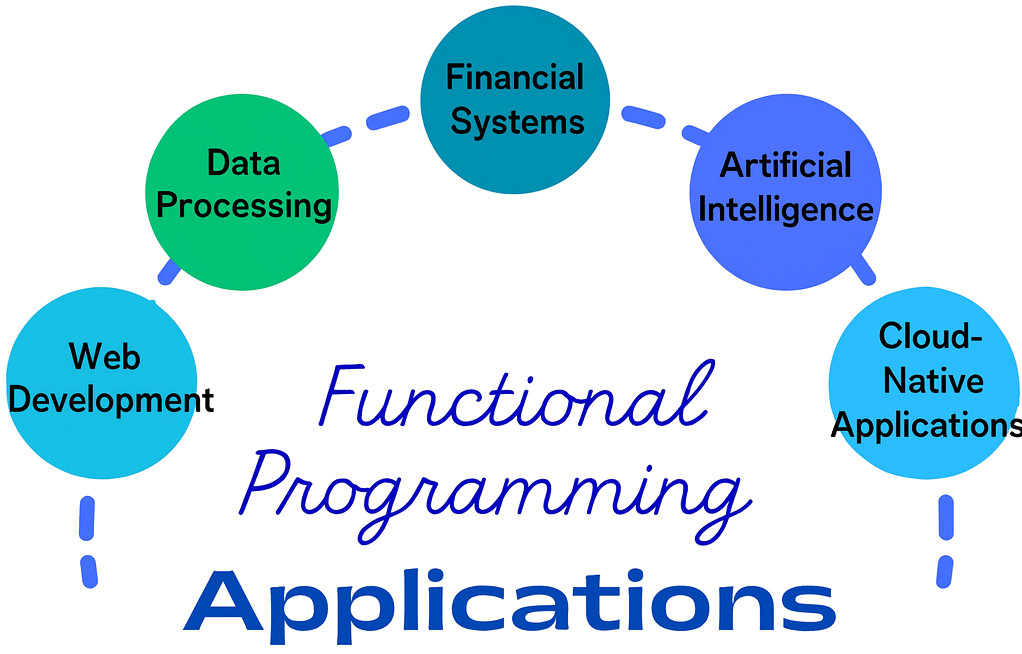What is Functional Programming?
|
|
There are numerous ways to build a software application; one of them is Functional Programming (FP). It is based on the idea of building software by writing functions, thereby avoiding shared state and mutable data. In contrast to imperative programming (aka procedural programming), which focuses on performing tasks as a sequence of statements, FP focuses on what to compute.
| Key Takeaways: |
|---|
|
In this article, we will cover the following:
|
This article will discuss functional programming in detail with its core concepts, use cases, benefits, and challenges.
Functional Programming Meaning
Functional programming, or FP, is an approach to software programming that uses pure functions to create maintainable software. Conversely, FP builds programs by applying and composing functions.
The origin of FP can be traced to the Lambda calculus, a framework developed by Alonzo Church to study computations with functions. It is the smallest programming language in the world and defines what is computable. According to this theory, anything that the lambda calculus can compute is computable. It is similar to a Turing machine in its ability to compute.
The Lambda calculus provides a theoretical framework for describing functions and their evaluation and forms the basis of current functional programming languages.
FP creates clean and elegant code by using functions with variables, arguments, and return values. It uses immutable data and avoids shared states. FP languages mainly focus on declarations and expressions, treating functions as first-class citizens. Functions can pass as arguments, return from other functions, and attach to names.
FP does not support loop statements and conditional statements. In general, FP focuses on the results.
Functional Programming Style
The most prominent characteristics of FP are as follows:
- FP languages are designed on the concept of mathematical functions. They use conditional expressions and recursion to perform computation.
- FP offers higher-order functions and lazy evaluation features.
- Functional programming languages do not provide flow control like loops and conditional statements, such as If-Else and Switch Statements. Instead, they directly use functions and functional calls.
- Like Object-Oriented Programming (OOP), FP languages support popular features such as Abstraction, Encapsulation, Inheritance, and Polymorphism.
Functional Programming Concepts
FP supports seven main core concepts around which this entire paradigm revolves. These core concepts are explained below:

1. Pure Functions
It is a function whose output depends only on its input values, without any observable side effects. Pure functional programming is a subset of FP and treats all functions as deterministic mathematical or pure functions.
A pure function:
- Provides the same output for the same input, irrespective of anything else.
- Does not modify any external state or arguments and thus does not have noticeable side effects.
- Does not perform any hidden I/O operations.
- Is deterministic. Its only result is the value it returns.
def sum(x,y): return x+y # Calling the function using the parameters print(sum(2,3))
This is a pure function that depends only on its arguments and returns a value based only on those arguments and not on any other external factors.
counter = 0 def incr(): return counter + 1 #external variable is modified and returned # Calling the function print(incr())
Here, the function incr () modifies and returns an external variable counter. This is an impure function.
2. Immutability
A variable is said to be immutable if its value cannot be changed once it is assigned. Functional programs create new copies with updated values instead of modifying data.
Example:
original = [1, 2, 3] modified = original + [4]
In this code, the original array has three values. If a fourth value is to be added, a new copy of the array is created and named modified, to which one more value is added.
3. First-Class and Higher-Order Functions
First-class functions treat functions as values, and they can be assigned to variables, passed as arguments, and returned from other functions.
Higher-order functions operate on other functions, either by taking them as arguments or returning them.
Example:
def greet(name):
return f"Hello, {name}!"
# Assigning the function to a variable
mygreeting = greet
# Calling the function using the variable
print(mygreeting("Max"))
The first-class function greet() is assigned to the first-class variable mygreeting. Then, the variable mygreeting is printed, which is nothing but the output of the greet () function.
numbers = [1, 2, 3, 4] squared_numbers = list(map(lambda x: x**2, numbers)) print(squared_numbers)
In this code, the map function is applied to each item of an iterable and returns a map object.
4. Function Composition
Using function composition, simple functions are combined to build more complex functions.
Example:
def add_three(x):
"""Add 3 to the input."""
return x + 3
def multiply_by_four(x):
"""Multiply the input by 4."""
return x * 4
# Compose the functions: first add_three, then multiply_by_four
# This means multiply_by_four(add_three(value))
result = multiply_by_four(add_three(2))
print(f"Result of composing add_two and multiply_by_three with input 2: {result}")
add_three and multiply_by_four. Then there is a statement:result = multiply_by_four(add_three(2))
Here, a function is called inside another function, achieving function composition.
Function composition promotes code reuse and modularity.
5. Recursion
Recursion is a programming technique in which a function calls itself repeatedly.
Functional languages rely on recursion instead of loops for iteration, as these languages have no while or for loops. Recursion in FP simulates iteration.
Example:
def factorial(n): """ Calculate the factorial of a number using recursion. """ if n == 0: # Base condition: factorial of 0 is 1 return 1 else: return n * factorial(n-1) # Recursive step: n * factorial(n-1)
This program’s function factorial () is called until the base condition (n==0) is reached.
6. Referential Transparency
A referentially transparent expression can be replaced with its value without changing program behavior. This property helps create more predictable and testable programs.
FP supports immutable variables and does not have assignment statements. If some value is to be stored, a new variable is defined instead of changing the existing value. Thus, the state is constant at any instant and eliminates any chances of side effects of replacing a variable with a new value.
Example:
Consider an expression, 2 + 4, that evaluates to 6. If any instances in the program use this expression, like 2+6 * 4, you can replace it with the value 6, so the expression becomes 6 * 4. This does not change the program’s outcome. Thus, 2 + 4 is a referentially transparent expression.
Now consider a statement, x = x+1
In the above expression, the value of x changes, which might affect the program’s outcome. Hence, this is not a referentially transparent expression.
7. Lazy Evaluation
FP supports the concept of lazy evaluation, in which computations are delayed until the result is required. This improves performance by avoiding unnecessary calculations before they are even needed.
The lazy evaluation technique, called ‘Call-by-Need’, is beneficial for optimizing performance, handling infinite data structures, and improving code modularity.
Instead of calculating the value immediately, lazy evaluation creates a “thunk” or a suspended computation with instructions for calculating a value. When the need arises, this thunk is executed, and the value is stored for future use.
Example:
The following FP languages support lazy evaluation:
- Haskell: This purely functional language relies heavily on lazy evaluation.
- Scala: This can be configured to use lazy evaluation for specific expressions or variables.
- Python: Python’s functions, such as map and filter, when used with iterators, can implement lazy evaluation.
Popular Functional Programming Languages
Not all programming languages support functional programming (FP). Some were designed specifically for FP, while others support functional and object-oriented programming.
The following table provides information about popular languages used for functional programming:
| Programming Language | Description |
|---|---|
| Haskell |
|
| Erlang |
|
| F# |
|
| JavaScript |
|
| Python |
|
| Java |
|
| Scala |
|
| Clojure |
|
| OCaml |
|
Languages like JavaScript, Python, Scala, Ruby, and Java support functional programming features, though they are not purely functional. They are mainly OOP languages. Hence, these languages are known as multi-paradigm languages.
Benefits of Functional Programming
FP has numerous benefits, some of which are listed here:
- Modularity and Reusability: Functions perform only one task and can be easily composed into larger systems. Pure functions and function composition achieve modularity, and the system is more reliable.
- Testability: Testing is easier because FP supports pure functions and referential transparency.
- Better Abstractions: Support for functions like
map,reduce, andcomposeabstract common programming patterns. - Bugs-Free Code: Functional programming supports immutability, so there are no side effects, and we can write error-free code. The immutable state reduces accidental changes, improving reliability.
- Efficient Parallel Programming: There is no state-change issue in FP, as languages have no mutable state. Functions can be programmed to work in parallel as instructions. The lack of shared state eliminates race conditions and simplifies parallelism.
- Efficiency: Functional programs are more efficient as they consist of independent units that can run concurrently.
- Supports Nested Functions: Nested functions are available in FP with support for function composition.
- Lazy Evaluation: Functional programming supports lazy evaluation functionality constructs like Lazy Lists, Lazy Maps, etc.
Object-Oriented Programming vs. Functional Programming
OOP uses an imperative programming model, meaning functions are coded in every step needed to solve a problem. FP, on the other hand, uses a declarative programming model, meaning it relies on the underlying concepts of a programming language to execute necessary steps to reach a deterministic outcome.
Imperative programs rely on the step-by-step process of solving a problem, whereas declarative programs focus on the result of solving a problem.
The following tables illustrate significant differences between functional programming and OOP:
| Functional Programming | OOP |
|---|---|
| Follows Declarative Programming Model | Follows the Imperative Programming Model |
| Uses Immutable data | Uses Mutable data |
| Focus is on: What to solve? | Focus is on: How to solve? |
| Suitable for Parallel Programming | Not ideal for Parallel Programming |
| Its functions have no side effects | Its methods can produce serious side effects |
| Flow Control is through recursion | Flow control is using loops and conditional statements |
| It uses the “Recursion” concept to iterate over the data collection | It uses the “Loop” construct to iterate over a data collection |
| Execution order of statements is not so important | Execution sequence of statements is critical |
| Supports both “Abstraction over Data” and “Abstraction over Behavior” | Supports only “Abstraction over Data” |
Challenges and Criticisms
FP also has several challenges, although benefits often outweigh the challenges. Here are the challenges FP faces:
- Performance Overhead: FP creates an excessive number of intermediate data structures, which can lead to inefficiencies. Using recursion and immutable values can decrease performance.
- Tooling and Ecosystem: FP languages have smaller communities and limited libraries than imperative languages.
- Code Readability: Writing pure functions may reduce code readability. Additionally, it is challenging to write programs in a recursive style instead of loops.
- Terminology Problems: FP has a lot of terminology that may be difficult for a layman.
- Recursion: This is one of the best features of FP, but it is also very expensive to use. Recursive functions utilize high memory and may prove costly as they grow larger.
- Learning Curve: Several concepts in FP, such as recursion, monads, and immutability, can be challenging for beginners to learn.
When to Use Functional Programming
Functional programming has numerous uses. The following are the top use cases for FP:

Web Development
- Modern web development uses FP to create web applications and user interfaces.
- React (JavaScript library) uses functional concepts like stateless components and hooks.
- Elm and ReasonML are functional web frameworks.
Data Processing
- FP can handle large datasets and also supports immutability and pure functions without any side effects.
- FP is suitable for data processing and analysis.
- Apache Spark’s APIs encourage FP with
map,filter, andreduceoperations.
Financial Systems
- FP supports features like immutability, lazy evaluation, concurrency, and parallelism, which make it ideal for use in financial systems with critical transactions.
- Languages like F# and Haskell are used in banks for risk modeling and pricing.
Artificial Intelligence
- Functional constructs simplify the processing of complex data pipelines since FP can handle large datasets. Read: AI In Software Testing: Join The AI Testing Tools Era.
Cloud-Native Applications
- FP is well-suited for cloud-native application development with emphasis on statelessness and immutability.
- Kubernetes uses FP to ensure deployment security. Read: What are Docker and Kubernetes and why do I need them?
Future Trends in Functional Programming Paradigm
Functional programming is set for continued growth and influence, integrating into mainstream languages and applications. Some emerging trends for FP are as follows:
- Increased Adoption and Integration: Functional-first languages are gaining traction, with languages like Haskell, Elixir, Scala, and Clojure seeing increased use in different domains and enhanced community support.
- AI-Powered Development: AI tools automate code generation and debugging for FP and assist in tasks like code completion and bug detection, and they may generate entire code blocks. Read: Generative AI in Software Testing.
- Impact on Web Development and Machine Learning: Web development frameworks are completely adopting functional programming models, a new approach to building web applications with improved concurrency and scalability. Read: Machine Learning to Predict Test Failures.
Conclusion
Functional programming offers a powerful alternative to imperative programming models like OOP by providing clean, predictable, and maintainable code. Its roots in mathematics make it more powerful than other languages in computation. With its growing influence in mainstream language, functional programming is no longer limited to academia.
FP equips developers with features for building robust systems in concurrent, distributed, and high-assurance environments. Understanding the crux of FP will broaden your perspective and improve your software design skills, regardless of your role.
| Achieve More Than 90% Test Automation | |
| Step by Step Walkthroughs and Help | |
| 14 Day Free Trial, Cancel Anytime |












